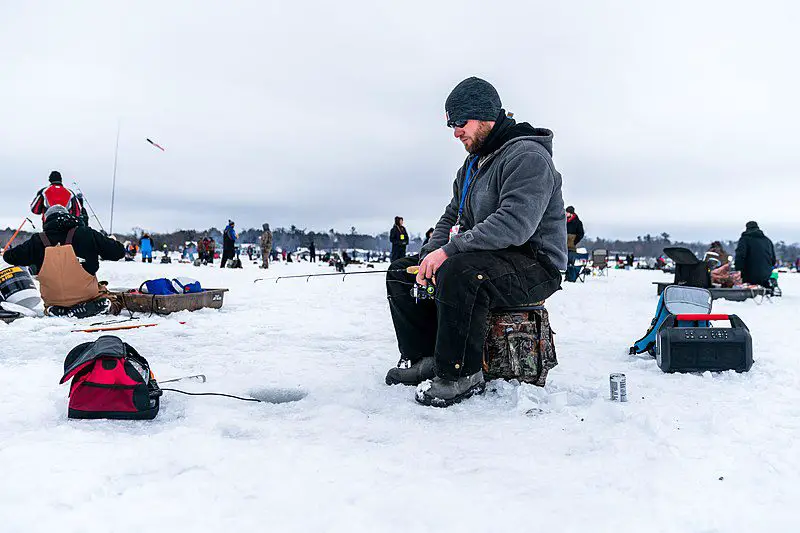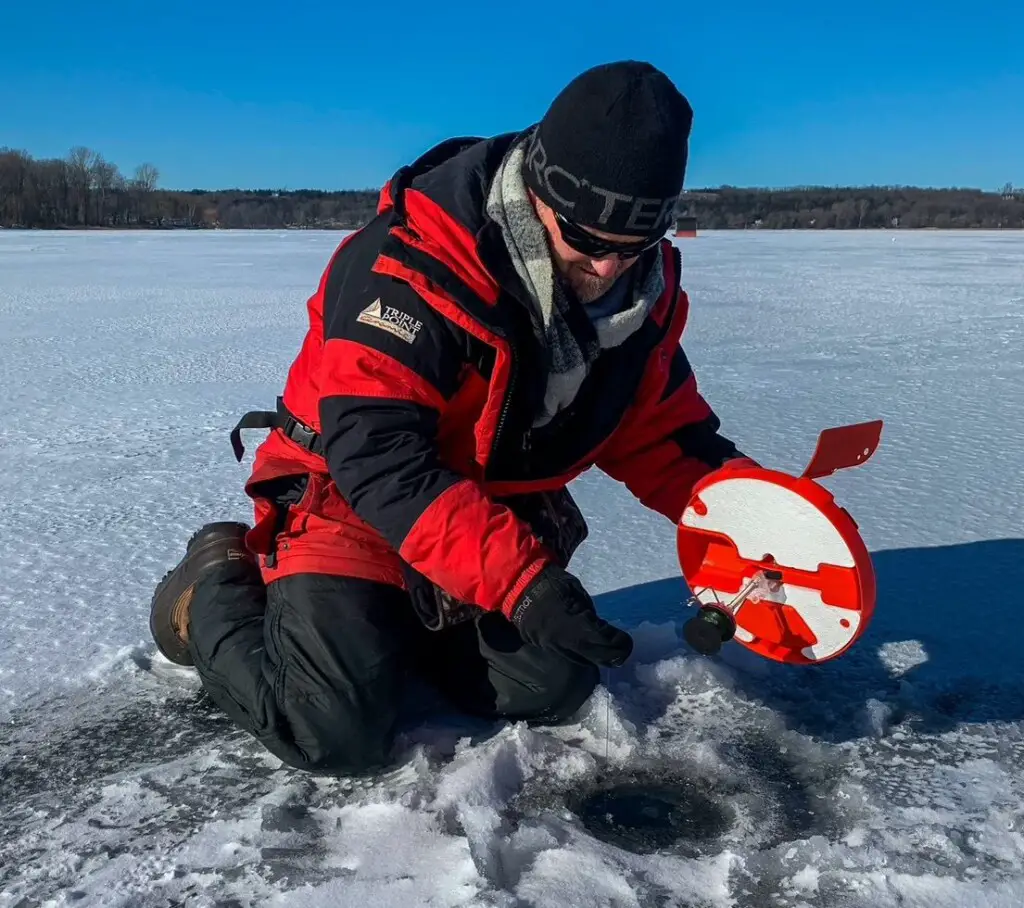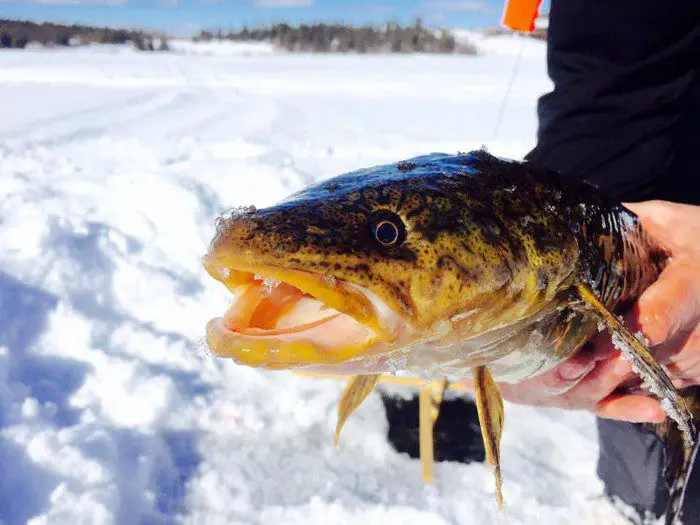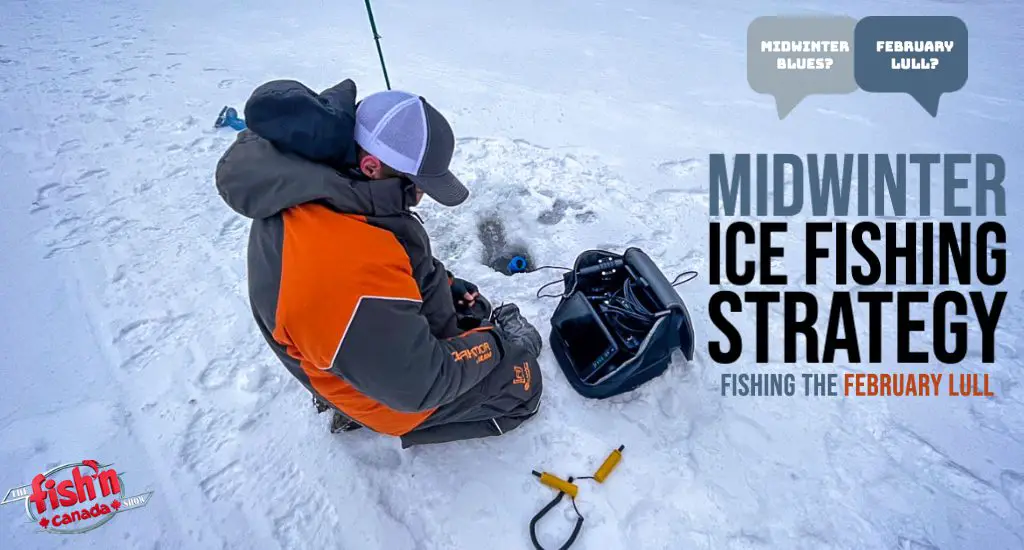The middle of the winter is a dreaded time in the world of ice fishing. Some people call it the midwinter blues, others the February lull.
However, no matter what you call it, one thing is clear: ice fishing gets tough in the middle of winter.
So, in honour of this notorious season being upon us once more, we decided to take a deep dive into why fish seem to take the middle of the winter off and provide you with some ice fishing strategies and techniques that will keep you on fish while all others simply endure the annual “blues”.
The Science of Slow: Why does ice fishing slow down mid-winter?

Whether you’re out on the big waters of Lake of the Woods or out on a small back lake in northern BC, it is inevitable that fish slow down during the middle of winter. But after such a promising start to the season and only a few weeks to go before the sought-after late-ice bite, what causes this brief cease in action?
Slowing Metabolisms
Winter is perhaps the one time of the year that we can guarantee that fish refusing to bite is not your own doing.
Since most fish are cold-blooded, they rely on outside sources to regulate their body temperatures as, unlike us, they are unable to create and store their own heat. This means that the bodily functions of fish are largely influenced by their environments and that changing conditions have large effects on how they behave.
The most notable of these cold-water adjustments is the slowing of the fishes’ metabolism, requiring them to eat and move far less when temperatures reach their frigid winter lows. This is only exasperated as time in these temperatures increases, explaining why fish during early ice season are so much more aggressive than those in the middle of winter.
Lack of Forage
Lack of forage is another reason why fishing tends to slow down in the middle of winter.
This is especially true for weed-bound forage, as the amount of sunlight penetrating through the thick, midwinter ice is low enough to kill off large amounts of weeds and send the rest into a dormant state.
Trout species, such as Brook Trout, Rainbows, and Splake are the main sufferers when this occurs and is why these fish are so sought after at first-ice and so often ignored during the middle of the season.
Reduced Oxygen Levels
Sun is not the only thing that has trouble penetrating ice, oxygen has trouble as well.
While it may be true that cold water holds oxygen better than warm water, the thick ice sheet on top of the lake is enough to keep a large percentage of oxygen in the atmosphere from penetrating the water.
In layman’s terms, ice covering a lake is like putting a lid on a jar or a cover over a pot. Once covered over, oxygen cannot easily get in.
This drastically reduces the amount of dissolved oxygen present in the lake by midwinter and makes fish slow and lethargic as a result.
Angling Pressure

Contrary to popular belief, angling pressure is one of the least significant contributors to the February ice fishing lull, but its influence is still worth mentioning.
The photo above is an extreme example but many lakes nearby popular town centers do see angling pressure reminiscent of this photo. In these “community holes” it is undeniable that fish do become much wearier as the season goes on and that midwinter, when the ice is thick and the lakes are accessible to all, is when this is felt the most.
Certain species are more susceptible to these increases in angling pressure as well, with Walleye, Yellow Perch, and Lake Trout rounding out the big three in many Canadian lakes.
Beating the Midwinter Blues:
Tip 1: Change Location
Our first piece of advice for those looking to stay on fish throughout the slow, midwinter period is to change locations.
As mentioned above, community holes will become less and less effective as the season goes on, making long walks and a bit of exploration well-worth the effort when things get slow. This could even include doing a bit of research and tracking down a less-known back lake that has not been hit quite as hard as your local lake.
Another great option during the midwinter is flowing water. Since many rivers and streams see some amount of open water throughout the winter, these are great sources of oxygen for the lake and many baitfish, and their predators, will stick near these areas. This is especially true of species such as Northern Pike and Walleye that use these areas to spawn.
As we have mentioned plenty of times here at Fish’n Canada, fishing moving water is dangerous and anglers should not take safety for granted. Midwinter may be one of the safest times to explore areas with a bit of current, but those attempting it should have all their safety gear at the ready and take all precautions when heading to unknown areas. For more information on ice safety, check out the link below:
Tip 2: Change Tactics
 Pete Bowman slowing things down by doing some tip-up fishing
Pete Bowman slowing things down by doing some tip-up fishing
Changing tactics is another excellent strategy for midwinter ice fishing.
Slowing things down is the first tactic change to consider, especially for targeting Walleye. As mentioned above, the lack of oxygen and the extended exposure to cold water is going to have most gamefish species feeling lethargic. To catch fish when they are in this stage, it is often necessary to slow things down to their level, adding more dead stick presentations into your repertoire or employing set lines like tip-ups or jaw-jackers.
In addition to slowing things down, downsizing your presentation is also a great option. Simple tungsten jig heads and minnows (or minnow heads) become especially effective this time of year as the live bait will do the majority of the work for you. Small jigging spoons tipped with live bait, such as Buckshots and Swedish Pimples, can also produce mid-winter Walleyes, Yellow Perch, and other baitfish-seeking gamefish this time of year.
Tip 3: Change Focus

Our final piece of midwinter ice fishing advice may seem a bit last-resort, but it can provide some of the most memorable days of the season. That is, simply: “fish for something else.”
Although it may be a tough pill to swallow for die-hard trout anglers, these fish are perhaps the most susceptible to the midwinter lull as their oxygen requirements are significantly higher than some of the other species they share the water with.
In a similar category, although Walleye are perfectly catchable during the middle of winter, their stubbornness shifts to an all-time high during the middle of the ice fishing season and those looking for efficiency will find much more of it elsewhere.
So what species are the answer to the midwinter blues?

Known by many names, the Burbot/Ling/Eelpout/Lawyer/Cusk is perhaps the perfect species to get you through the month of February as they only get more aggressive the deeper into winter we get.
This is because Burbot are one of the few species to spawn under the ice, with the peak of their activity occurring somewhere between February and March depending on how north the environment is.
During this spawning period, particularly at sundown and into the night, Burbot head to shallow water and congregate around gravel bars to spawn. Similar to Bass, Burbot aggressively protect their eggs during this period as well, making them especially dialled into any intruders (i.e. your bait and hook).
Fun fact: even non-spawning Burbot help out in protecting eggs and nests, meaning every Burbot in the lake participates in the midwinter migration.
Burbot are also some of the best-eating fish we have in this country, being the only freshwater relative of the Cod.
In conclusion, midwinter ice fishing is undeniably slow but with a bit of adjustment, it can be far less so. We’d love to hear what you all do to keep busy during the annual ice fishing slow down so give us your tips in the comments below!




